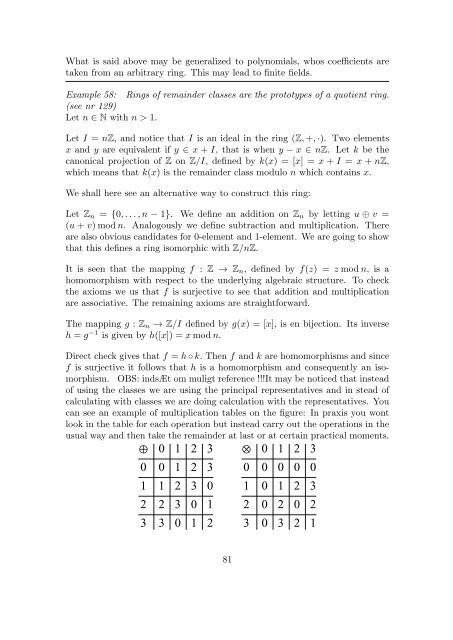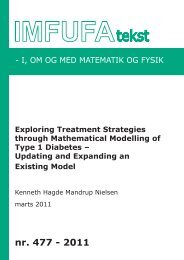ABSTRACT ALGEBRAIC STRUCTURES OPERATIONS AND ...
ABSTRACT ALGEBRAIC STRUCTURES OPERATIONS AND ...
ABSTRACT ALGEBRAIC STRUCTURES OPERATIONS AND ...
Create successful ePaper yourself
Turn your PDF publications into a flip-book with our unique Google optimized e-Paper software.
What is said above may be generalized to polynomials, whos coefficients are<br />
taken from an arbitrary ring. This may lead to finite fields.<br />
Example 58: Rings of remainder classes are the prototypes of a quotient ring.<br />
(see nr 129)<br />
Let n ∈ N with n > 1.<br />
Let I = nZ, and notice that I is an ideal in the ring (Z, +, ·). Two elements<br />
x and y are equivalent if y ∈ x + I, that is when y − x ∈ nZ. Let k be the<br />
canonical projection of Z on Z/I, defined by k(x) = [x] = x + I = x + nZ,<br />
which means that k(x) is the remainder class modulo n which contains x.<br />
We shall here see an alternative way to construct this ring:<br />
Let Zn = {0, . . . , n − 1}. We define an addition on Zn by letting u ⊕ v =<br />
(u + v) mod n. Analogously we define subtraction and multiplication. There<br />
are also obvious candidates for 0-element and 1-element. We are going to show<br />
that this defines a ring isomorphic with Z/nZ.<br />
It is seen that the mapping f : Z → Zn, defined by f(z) = z mod n, is a<br />
homomorphism with respect to the underlying algebraic structure. To check<br />
the axioms we us that f is surjective to see that addition and multiplication<br />
are associative. The remaining axioms are straightforward.<br />
The mapping g : Zn → Z/I defined by g(x) = [x], is en bijection. Its inverse<br />
h = g −1 is given by h([x]) = x mod n.<br />
Direct check gives that f = h ◦ k. Then f and k are homomorphisms and since<br />
f is surjective it follows that h is a homomorphism and consequently an isomorphism.<br />
OBS: indsÆt om muligt reference !!!It may be noticed that instead<br />
of using the classes we are using the principal representatives and in stead of<br />
calculating with classes we are doing calculation with the representatives. You<br />
can see an example of multiplication tables on the figure: In praxis you wont<br />
look in the table for each operation but instead carry out the operations in the<br />
usual way and then take the remainder at last or at certain practical moments.<br />
0 1 2 3<br />
0 0 1 2 3<br />
1 1 2 3 0<br />
2 2 3 0 1<br />
3 3 0 1 2<br />
81<br />
0 1 2 3<br />
0 0 0 0 0<br />
1 0 1 2 3<br />
2 0 2 0 2<br />
3 0 3 2 1
















